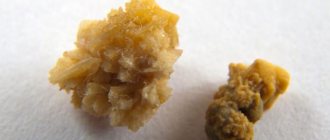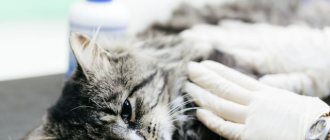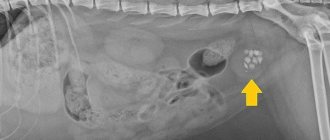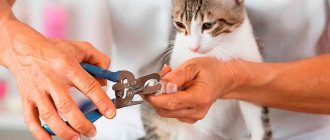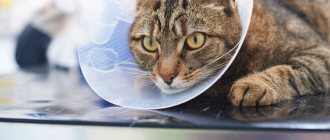Against the backdrop of information frenzy on the topic of Chinese coronavirus transmitted from animals, I would finally like to clarify a little and tell you what coronavirus is in cats and how it manifests itself. Zoo veterinarian Marina Mikheenko will help you figure this out .
This topic is special for me, since I had to deal with the coronavirus and its companions in full.
Reading how people in China go crazy with fear and throw healthy animals into the trash, only one thought comes to my mind - how you have to be afraid for your own life. If they don’t throw cats away, they pack them in plastic and masks so that the poor animal’s eyes bulge from stress. Thanks to the Chinese epidemic, the whole world learned the word coronavirus and got hundreds of horror stories, dragging dogs, cows, cats and even hamsters into it. And now let’s exhale. Coronavirus in cats is a completely different story and symptoms. It is not even transmitted to dogs from cats, let alone to people. And yes, he is not so deadly scary (although he has his unpleasant moments).
Meet Khardyusha. And he had a coronavirus infection for a whole year, with high titers. But the body outgrew and won, although it took effort and money to treat this cat disease.
Photo: Nathan Antonovich
Photo: Nathan Antonovich
Photo: Nathan Antonovich
Once again, I’m not saying that coronavirus in cats is a piece of cake. But in most cases this is not fatal (depending on the type of virus) and is not transmitted to people, even if you kiss a cat on the nose. In snotty and coronavirus.
– Coronavirus is an RNA virus found in all mammals. Has several types. It got its name for its similarity in structure to a crown (corona in Latin), explains veterinarian Marina Mikheenko.
That is, in fact, viruses are generally different, only the structure is the same.
What is coronavirus
This disease has become quite common since the last century. Until now, its treatment has been a challenge, since an effective vaccine against it has not yet been invented. The first official mention of the disease with characteristic symptoms appeared in the United States of America in 1960. However, it is believed that the pathogen was discovered several decades earlier.
Infectious peritonitis is common in all countries of the world. In addition to the bulk of reports of a terrible illness in pets, it was diagnosed in lions, leopards, cheetahs, jaguars, lynxes, caracals and other representatives of the cat family. On the territory of Russia it is often found among domestic animals, but among zoo animals - only among manul cats.
The causative agent of the strain is called a complex RNA virus. It is round with protrusions resembling a crown. Its discovery by scientists occurred recently, so there is no established scheme for vaccination and therapy. There is also no clear understanding of its nature. It has only been established that it is capable of mutation from a simple type to a more harmful one.
Doctors know of two types of coronavirus in cats:
1. Enteric strain (FCoV)
, which does not cause serious consequences for the cat. This form affects the cells of the small intestine, resulting in enteritis. Recovery occurs quickly, but the pet becomes a carrier of the infection for life.
2. Highly pathogenic type (FIPV)
, which is a dangerous form. It spreads throughout the body, causing fatal peritonitis. White blood cells - leukocytes - are also damaged.
The mutation of one strain into another, more dangerous species is the result of the pet’s low immunity and constant stress. The highly pathogenic species is much less common, but almost always causes death. Peritonitis is considered incurable if detected late. Despite the fact that the causative agents of the disease are the same, the symptoms are significantly different.
Scientists tend to distinguish between dry and wet infections. In the wet form, fluid accumulates in the abdomen, causing ascites. The doctor removes excess moisture from the abdominal cavity, and then transfers it to the dry subtype, followed by treatment.
The bacterium itself quickly dies outside the body, maintaining slight resistance to external factors for 24 hours. It is not transmitted from animal to person, but for other pets it can be deadly.
Preventive actions
Since the virus is localized in China, until the situation improves, it is not recommended to visit the Middle Kingdom or at least Hubei Province, where the city of Wuhan is located. You should lead a healthy lifestyle, exercise and eat well. You should not take popular antiviral drugs prophylactically, because they do not work, but you can buy pharmacy saline solutions to rinse your nose and throat, and do this several times a day. The mucous membranes of the nasopharynx are the first immune barrier for all viruses and bacteria on their way into the human body. Normally, these shells clean themselves, neutralizing all pathogenic microflora that have settled on their surface. But due to a lack of fluid or other problems, the mechanism may malfunction, so after visiting public places, rinsing the nasopharynx is very advisable.
To prevent infection, you can wear a medical mask, but ordinary products are ineffective. Full protection is provided by masks with a HEPA filter of at least N95 class. It is also useful to protect the mucous membranes of the eyes, at least with ordinary glasses.
It is worth giving up culinary exotica, and eating only well-cooked eggs, meat and fish. It is necessary to thoroughly wash fruits and vegetables and keep your hands clean.
If signs of a cold appear, you should immediately consult a doctor. When coughing, cover your mouth not with your hands, but with a napkin, which must be disposed of immediately. If drops of sputum or saliva get on your hands, you should immediately wash them with soap, because they can become a source of spread of coronavirus.
Sources of infection
Young cats under two years of age, as well as older animals, are most at risk of contracting the virus. Only born kittens can receive it from their mother, which is why the death of the babies will be almost inevitable. Low immunity, poor heredity, unsanitary living conditions become factors that provoke the disease.
It has been established that the main source is contact with an infected individual living in the same territory, encountered on a walk or provided for mating. It is not for nothing that the disease is called a problem for all nurseries, since overcrowding has a beneficial effect on the spread of infection. There is evidence that from 50 to 85% of nursery inhabitants are sick or are passive spreaders of the strain.
Don't forget about this when buying a kitten. You must ask the seller for veterinary documents reflecting the results of tests performed and information on primary comprehensive vaccination.
The penetration process is facilitated by:
- eating excrement;
- use of shared hygiene items or utensils;
- unsanitary conditions of detention;
- constant close contact of cats with each other.
Pets that exist separately from their relatives are least susceptible to infection. If a cat lives alone with its owner, gets little walks, and encounters with other cats are kept to a minimum, then the likelihood of contracting an infection is practically non-existent. However, there have been cases of the bacteria entering homes through infected feces, particles of which end up on the wheels of a bicycle, baby stroller or the sole of a shoe.
Signs do not appear immediately. The incubation time for development within the body is about three weeks, but in weakened or old animals, manifestations will begin within 3-4 days.
Probability of infection
Veterinarians are still arguing about why some cats become infected with coronavirus, while others are spared the disease. Many experts are of the opinion that the animal’s immunity plays a major role. As a rule, the strongest organism is found in young healthy individuals aged 2 to 8-10 years. Accordingly, the risk group includes:
- kittens up to 1 year, large breeds – up to 1.5 years;
- elderly individuals - from 10 years and older, thoroughbreds - from 8 years and older;
- albino and allergic animals;
- animals with a chronic disease or recently recovered from it.
Of course, even a young, healthy cat can catch the coronavirus. Its susceptibility will be determined not only by the strength of the immune system, but also by the type of virus.
Danger to humans
Much to the relief of many owners, the coronavirus is not transmitted to humans. But this does not mean that precautions do not need to be taken - people can become carriers of the infection.
If your cat is sick with coronavirus, try to limit your contact with other animals so as not to transfer the strain to them. Disinfect the room – and more than once. Maintain a strict cleaning schedule.
If you have other pets, if possible, temporarily relocate them to another house or apartment to prevent them from becoming infected. This applies not only to cats, but also to dogs.
6) If I am sick, how can I protect the people I live with?
Elisa Choi, an infectious disease and internal medicine specialist in Boston, says coronavirus patients should stay in an isolated room and (ideally) not share a bathroom with other family members.
“They should try to stay as far away from anyone in the house as possible, at least two meters away,” she added. If you share a bathroom, avoid being in the room at the same time as anyone else. WHO has found that most transmission of the virus in China occurs between family members.
If the patient feels fine, then ideally he should be the one who disinfects the bathroom after using it himself. If you are unable to fully isolate yourself from others in your home, tell your doctor.
The website of the Russian Ministry of Health lists recommendations for disinfecting surfaces and premises. Don’t forget that you need to disinfect everything you frequently come into contact with: counters, countertops, door handles, plumbing fixtures, toilets, phones, keyboards, tablets, bedside tables, etc. It is recommended to do this every day. Gloves should be worn when touching potentially contaminated items, such as used clothing or bedding, and when disinfecting frequently used surfaces. When you're done, throw the gloves in the trash—and then wash your hands.
Choi suggests washing your hands frequently to protect those around you and covering your nose and mouth when you cough or sneeze with a tissue. If you feel sick, do not share cups, dishes, personal care products, bedding or anything else with anyone.
The rules of behavior for coronavirus infection are similar to those for the flu or a cold.
Forms of the virus
The course of the disease directly depends on the bacteria that has entered the body of the individual. They build on it when prescribing medications and therapy. There are three options for the development of malaise:
- asymptomatic;
- easy;
- heavy.
First option
considered the most common. This strain poses a threat not to the carrier, but to domestic relatives living in the neighborhood.
Mild course
typical for adults. Infection with bacteria provokes the development of enteritis. Diarrhea, high fever, runny nose, eye inflammation, and vomiting accompany the disease. The animal experiences pain in the abdomen, and a white coating forms on the tongue. Coronavirus enteritis in cats combines symptoms of poisoning and colds.
Severe leakage
associated with a sharp deterioration in condition, loss of appetite, and vomiting. Weight loss begins, mucous membranes begin to turn pale. With the wet subtype, ascites develops - accumulation of fluid in the abdomen, dysfunction of the kidneys, liver, and vascular damage. Muscle tissue gradually loses elasticity, and cramps are possible due to disturbances in the functioning of the nervous system.
The dry subtype is characterized by a sharp decrease in weight, and in later stages – a problem with the functioning of internal organs. The infection often combines both types or one begins to mutate into the other.
Wet inflammation without proper treatment lasts for about six months, then becomes dry, causing the death of the pet. Dry peritonitis is considered chronic, slowly and over a long period of time destroying the cat’s body.
COVID-19 in Brief: What you need to know
COVID-19 is an acute infectious disease caused by the coronavirus SARS-CoV-2 (2019-nCoV). It occurs in mild or severe form. The main danger of coronavirus infection is the high probability of developing viral pneumonia against its background, which provokes acute respiratory failure and other complications.
Common symptoms of COVID-19:
- increase in body temperature,
- fast fatiguability,
- general weakness,
- dry cough,
- nasal congestion,
- sneezing,
- headache.
Other signs of infection include joint and muscle pain, conjunctivitis (inflammation of the lining of the eye), sore throat and skin rash, mainly on the fingers and toes. Be careful, these symptoms do not develop in all cases.
Main symptoms and signs
The incompletely understood appearance of the strain makes it difficult to quickly identify the problem. Even an experienced veterinarian, when diagnosing a disease, can be confused due to the large number of symptoms. Because of this, conclusions that are not always correct are often made. Sometimes the owner needs to insist on involving several qualified specialists in the identification and examination, who can confirm or refute the previously received diagnosis.
Incubation period
Unfortunately, neither the owner nor the doctor is able to notice the coronavirus while it is at the initial stage of development. The incubation period does not involve any external manifestations, and it can last from two weeks to one month.
The only way to detect the disease at an early stage is to get tested. Diagnosis at a veterinary clinic is strongly recommended in the following cases:
- the indoor cat met his street brothers;
- you moved into a house where other animals previously lived;
- you took another cat or dog into your home (then it is better to examine all the animals at once);
- the domestic cat has been outside, had contact with suspicious objects, marks of other cats;
- If the cat regularly goes outside, it is better to get tested quarterly.
Such a strict, at first glance, check will protect your pet not only from coronavirus, but also from other, no less dangerous and unpleasant diseases.
First manifestations and symptoms
As soon as the incubation period ends, a severe stage of the course begins. It is expressed by one or more signs. Their list is very extensive:
- lack of appetite;
- frequent vomiting, diarrhea with blood or mucus;
- weakness, depression;
- alternation of high and low body temperature;
- unexpected attacks of aggression, panic, inappropriate behavior;
- fear of light, search for a shaded room;
- change in color of the oral mucosa and gums from red to light blue;
- germination of blood vessels in the cornea;
- bloating of the abdominal cavity due to accumulated fluid;
- decline in immunity at the cellular level.
The wide variety of manifestations is explained by mutations of infected cells. Not all signs occur even with the highly pathogenic form of coronavirus in cats. How many there will be depends on each specific case. For example, an asymptomatic appearance does not entail any consequences visible to the owner. A mild form suggests a gastrointestinal disorder, which is associated with poisoning or overeating.
The most terrible subtype develops gradually. It all starts with digestive problems, then the cat’s kidneys, liver and nervous system are affected, causing painful, hard-to-bear cramps.
Prevention
The only protection against any feline infection is vaccination. In the case of coronavirus, today there is only one vaccine, known in Russia, Primucell in the form of nasal drops.
The International Small Animal Veterinary Association (WSAVA) does not recommend the use of such vaccination for a number of reasons:
- the preventive effect has not been proven;
- side effects have not been studied - in a number of countries its use has been abandoned for this reason;
- effective only against enteritis, does not protect against infectious peritonitis;
- if the individual is already infected, then vaccination can provoke a severe form of the disease;
- The vaccine is contraindicated in kittens under four months of age.
To protect your cat as much as possible from this serious illness, certain measures should be followed:
- daily high-quality cleaning of premises with disinfectants (especially in nurseries);
- mandatory quarantine and PRC testing for new animals;
- restriction of walking in unfavorable areas;
- avoiding contact with street and stray animals;
- proper care;
- lack of stress in cats (significantly reduces immunity);
- annual vaccinations of cats against common diseases (Tricket, Multifel, Nabivak-Rabis);
- nutritious diet, use of high-quality feed;
- course intake of antioxidants - twice a year;
- quarterly deworming;
- flea and tick treatment (especially for outdoor cats);
- Sterilizing stray animals will help prevent the spread of the disease.
Diagnosing coronavirus in cats
Currently, there are no clearly developed medical tests to quickly and unambiguously determine the type of virus - enteritis or peritonitis. But there are a number of tests that can more accurately draw a conclusion about a problem with internal organs.
First of all, stool is analyzed for PCR and ICA three times over two weeks. The test indicates the presence of infection in the excrement. A negative result indicates not only its absence, but also a hidden disease that threatens healthy relatives.
If the signs clearly appear, then do the following studies:
:
1. Serological blood test
animal that can detect the presence of antibodies. The analysis does not allow determining the location of bacteria, and a negative result does not indicate its complete absence. This is sometimes caused by severely depleted immunity.
2. Blood polymerase chain reaction (PCR)
RNA detector. The test is not considered accurate and sometimes produces false positives and false negatives. The first is possible due to low virus activity, the second may be due to a lack of biomaterial for research.
3. Blood antibody titer
, capable of establishing the quantity and concentration of antibodies. The analysis helps to find out how severe the variant is in the animal. The highly pathogenic type is defined by a titer of 1280 antibodies or higher.
If peritonitis is suspected, it is necessary to urgently perform a biopsy and histology of the infected tissue. A puncture is taken from the abdominal cavity, removing fluid for analysis.
With the development of veterinary medicine, rapid tests have appeared everywhere to recognize coronavirus in those who have come into contact with sick cats. Such a test can identify the problem at an early stage and begin adequate therapy in time.
9) The walls are pressing on me. Children are constantly naughty. I'm going crazy in quarantine. Help!
Many people are stressed due to the forced transition to remote work, quarantine after traveling to areas with a high risk of infection, and the flow of negative information. If you are afraid of getting sick, you should remember that it is normal to worry about the whole situation. You are not alone. In case of severe anxiety, consult with a psychotherapist online - this is the best solution. Moreover, there are quite a lot of services offering such a service.
Please know that the situation is not hopeless, and good behavior in the community can go a long way in combating the spread of this disease. China has now closed all of its temporary hospitals as the number of cases continues to decline. But the social and economic impacts of this pandemic could last for months, so mentally prepare for it.
Treat the situation as a new opportunity for self-development - take online courses in a new profession, learn a foreign language. In the end, the pandemic will end - and new knowledge will remain with you.
Many services have become available for free, so you can entertain yourself or engage in self-development and knowledge acquisition.
How to treat a pet
At this stage of medical development, there is no single method to get rid of a dangerous strain forever. There is not a single medicinal complex that can cure a furry patient. Immunologists are delayed in creating a vaccine against coronavirus in cats.
General therapy
Currently, the therapy used eliminates only the symptoms, preventing the occurrence of complications. Almost every recovered individual becomes a carrier of the infection inside its body.
in a cat is treated in several stages and techniques
:
- prescription of antiviral medications;
- taking corticosteroids and antibiotics to eliminate inflammatory processes;
- prescription of immunomodulators to increase protective functions;
- the use of sorbents that allow the removal of toxins and waste from the pet’s organs (“Polysorb”, activated carbon, “White coal”);
- taking protectors or prebiotics to treat secondary factors of the disease;
- the use of antispasmodics using intramuscular injections (no-spa, papaverine);
- prescription of antiemetic drugs (Metoclopramide, Pro-chlorpromazine);
- the use of droppers with glucose solution, vitamins for severe dehydration or weight loss;
- collection of fluid from the pleural and abdominal cavity.
Drug "Poliferrin-A"
considered one of the best immunomodulators. Being an analogue of colostrum, the drug has a strong antiviral and anti-inflammatory effect.
Another medicine known as Roncoleukin
, allows you to stimulate the awakening of weakened immunity.
The drug "Globcan-5"
provides the mustachioed pet with the necessary antibodies.
Sometimes your veterinarian will prescribe human immunomodulatory medications. However, they are prohibited when the strain mutates into a more severe subtype, so as not to worsen the patient’s condition.
Treatment of enteritis
Relieving intestinal inflammation begins with strictly limiting the furry pet's diet. The suffering patient is not fed at all for the first 24 hours after diagnosis of the disease, leaving only fresh drinking water available. If the dehydration of the body is very severe, then special glucose solutions or vitamin preparations are used to maintain optimal electrolyte levels.
If the course of the disease is favorable, oatmeal porridge boiled in water is given on the second or third day. Viscous cereal envelops the intestinal walls, thereby accelerating the recovery of the damaged organ and increases the motility of the gastrointestinal tract. On the doctor’s recommendation, a small amount of lean minced meat is added to the diet a few days later.
Often, veterinarians perform intestinal lavage using castor oil or Glauber's salt. The use of these drugs depends on the complexity of the inflammatory process. In case of severe frequent loose stools, the patient is prescribed astringent medications, which are given under the strict supervision of a doctor.
If the high body temperature does not subside and the diarrhea does not stop, then the specialist prescribes a course of antibiotics, which should stop the development of complications against the background of a spreading infection. Such medications can be prescribed by injection, dropper, or tablet.
Viral enteritis involves antiviral rehabilitation and the prescription of immunomodulatory medications to restore the body's protective functions. In case of hemorrhage in the digestive section, hemostatic drugs with vitamin K are used. To ensure faster recovery of the infected area, taking vitamin-mineral complexes is indicated.
Features of the treatment of peritonitis
Can severe intestinal inflammation be cured? This question worries every owner of a cat with this terrible disease. Unfortunately, the mortality rate for this diagnosis is about 90% of cases. There is no single adequate treatment, but there is a set of measures aimed at maintaining a more or less normal condition of the infected patient.
The prescription of painkillers is aimed at blocking severe pain. Ice compresses are used for the same purpose. They are applied to the inflamed abdominal cavity to at least slightly relieve the acute pain. The set of measures directly depends on the type of inflammation diagnosed.
The viral form involves taking antiviral medications plus medications that reduce pain. In addition, immunostimulants and vitamin complexes are prescribed. For infectious inflammation, antibacterial solutions and antibiotics are used as intramuscular or subcutaneous injections.
The dry type is treated with immune-boosting drugs, pain-relieving injections, and a course of antibiotics. To reduce intoxication, glucose solution and saline solution are used.
If your pet is suffering from wet peritonitis, your veterinarian will perform intestinal lavage, which pumps out fluid from the abdominal cavity. This procedure will help reduce pain. A course of vaccinations with an antibiotic is also prescribed.
In general, all measures against inflammation are aimed at preventing possible complications. Any owner of a home mustache should remember that it is easier to prevent inflammation of internal organs than to cure it.
For lovers of conspiracy theories
At the end of January 2022, the famous blogger Tyler Durden published an article Did China Steal Coronavirus From Canada And Weaponize It, which states that the 2019-nCoV coronavirus is a product of developments by Chinese virologists working on secret projects to create biological weapons. The author reports that in March 2022, particularly virulent viruses were stolen from the Canadian NML laboratory, which subsequently ended up in China. This laboratory, which had biosafety level 4, among other things, studied dangerous coronaviruses. Later, Dr. Xiangguo Qiu and her husband Dr. Keding Cheng, whom the author calls Chinese agents working for the government's secret biological warfare program, were fired. One of the research institutes participating in this program is located in Wuhan, China - the Wuhan Institute of Virology of the Chinese Academy of Sciences. This institution is located just 20 miles from the fish market, which became the epicenter of the spread of the 2019-nCoV coronavirus. The blogger claims that these viruses are included in the Chinese biological weapons program and are therefore being actively studied in several laboratories, the funding of which is increasing year by year. The outbreak of the new coronavirus in Wuhan could be associated with the creation of these weapons.
It is difficult to say how reliable such information is. The truth is that such a laboratory does exist in Wuhan. It was created after the SARS-CoV outbreak specifically to study the pathogens that cause SARS. Such objects, as a rule, have a high degree of biological protection, therefore it is difficult to allow a banal leak of hazardous biomaterial into the external environment. Similar theories occurred at the beginning of the 20th century during the Spanish flu epidemic. Then there were persistent rumors that the new influenza virus was launched by the German company Bayer in order to increase sales of its drugs.
Be that as it may, many virologists and epidemiologists say: the world needs to prepare for the emergence of new viruses that will provoke mass cases of severe acute respiratory syndrome.
Caring for an infected person
During the treatment period, it is important that your pet receives appropriate care. The diet should also be reviewed. For example, if he received industrial feed before his illness, now he needs to be switched to natural food. The transition should be gradual, but mandatory. The consumption of protein contained in meat products is determined by the need to restore the tissue of the affected intestine as quickly as possible.
The cat should drink a sufficient amount of clean water. On the recommendation of a veterinarian, the patient is given decoctions of rosehip or stinging nettle. The doctor prescribes vitamins that help boost the pet’s immune system. Regular deworming is mandatory to maintain a normal standard of living.
Unsanitary living conditions negatively affect a cat’s recovery, so cleanliness is needed not only for the cat itself, but also among bowls, trays, various hygiene items, and toys. When two or more relatives live together in the same territory, they are provided with separate plates and toiletries.
Intestinal infections are treated only under the supervision of a veterinarian. Only a specialist can monitor the patient’s condition or change the treatment conditions during regular examination of the infected patient.
Causes of infection
The cause of coronavirus infection is a virus from the Coronaviridae family. Specifically pathogenic for cats are two closest relatives or strains of the same microorganism - FIPV and FECV. The first causes peritonitis, the second – enteritis.
During scientific research, it was found that FECV constantly circulates in the intestines of some felines, as if being in “sleep mode”. Under certain conditions, it takes on an aggressive shell, causing either minor intestinal inflammation or completely mutating into a highly virulent strain of FIPV.
Stages of the disease
Scientists have discovered three stages of the disease:
At the first stage, cats do not feel the disease. This may last indefinitely. At the second stage, pets experience mild discomfort, weakness, and gastrointestinal upset, which is quite easily tolerated by felines.
Note! During a difficult period, all processes in the cat’s body are disrupted. At the same time, it is practically impossible to help 5% of animals.
Since pets come into contact with sick individuals on the street, this contributes to accelerated transmission of infection. To avoid such troubles, you need to vaccinate your four-legged animal, which will protect it from infection.

